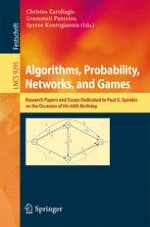2015 | Buch
Algorithms, Probability, Networks, and Games
Scientific Papers and Essays Dedicated to Paul G. Spirakis on the Occasion of His 60th Birthday
herausgegeben von: Christos Zaroliagis, Prof. Grammati Pantziou, Spyros Kontogiannis
Verlag: Springer International Publishing
Buchreihe : Lecture Notes in Computer Science
